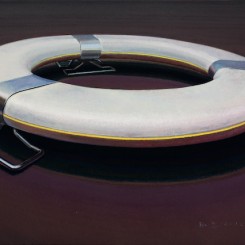“Groundless,” solo exhibition by Zhang Hui.
Long March Space (798 Art Zone, 4 Jiuxianqiao Road, Chaoyang District, Beijing). April 28 to June 17, 2012.
Four painted lifesavers in a line, arranged from biggest to smallest, each floating in space, painted, colored, designed for people, but empty. Their purpose presupposes emergency. They are nuclear zeros waiting for a victim nuclear family to save, to fill the void at the center. The smallest one casts a shadow doppelganger as it hovers.
Colin Chinnery writes in the catalog essay that returning to painting after years as an installation and performance artist, and as one of the “Post Sense-Sensibility” artists, Zhang has had to reinvent his approach to art completely. Whatever journey Zhang has been on, those lifesavers tell you it has been grueling. Chinnery sets up an interesting argument based on Heidegger’s “The Origin of the Work of Art” regarding earthly concealment (darkness) and worldly revelation (light) and understanding the “thingliness of things.” The perspective is helpful but does not account for how the most powerful symbols of painting come out of painting as image generator. These are not mere paintings of life-savers, but life-savers that are paintings.
Other notable works include portraits of people or busts of people (marble, polystyrene) stained with sunlight (inspired by the description of weather as “partly sunny”), such as “Relief Sculpture (Listening No. 1)” (2011). This painting reminded me of scenes of synesthesia in Krzysztof Kieslowski’s Three Colors: Blue (1993), wherein the lead character played by Juliette Binoche is bathed in sunlight refracted through blue glass as the chords from her dead husband’s music strike her.
The only weak part of the show is the portraits of the artist and his friends, Colin Chinnery and Gao Shiming. They are not bad portraits, simply unnecessary. The core of the exhibition is so strong that it does not need extraneous works, however interesting the biographical context may be.
I am not naturally drawn to realist painting but then, this is hardly that, not in the sense of verisimilitude, but a type of truth pulled up through the very canvas on which the paint has dried. It may be one of the most important painting exhibitions in China this year.
